Most Kit Up! readers know that next week the Army has scheduled an industry day up at the service's research lab in Adelphi, Md., to get all the proposals from industry on the Phase IV camo requirements.
As you'll remember, the service is asking industry to provide color schemes for three different terrain types -- jungle/woodland, desert and so-called "transitional" -- and a fourth pattern to be used across all the uniforms and printed on utility gear like body armor carriers, MOLLE gear and ECWCS outers.
Well, Hyde Definition has jumped into the frayalready with a full proposal of its PennCott pattern in three terrain variants and one "multi-terrain" pattern for gear.
As you can see from the pics above, it's a pretty good pattern (as I suspect all the offers will be) and it sticks to the current trend (with Crye being the exception) of using "fractal geometry" (ie, digital) to camouflage troops.
The PenCott pattern works by dithering the different contrasting colors and tones into and against one another to give the illusion of several more colors, and to create a combination of blurred and sharp edges and shapes. Complex patterns like this are harder for the human eye to process, and recognisable shapes such as human limbs, or the lines of pockets and seams, become more difficult to make out.The PenCott pattern is multi-directional, multi-scalar and includes both a micro-pattern and a macro-pattern for close range concealment and long range disruption. PenCott also includes an innovative midi-pattern (middle range), and false edges at the high-difference boundaries of the dark patches, to further confuse the eye. Moreover, the illusion of depth is created by the juxtaposition of high contrast shades with light tones - which, through an optical illusion due to the way humans perceive color, appear to recede or sit behind the warmer mid tones in the pattern.
Hyde does a good job selling their pattern, of course, but it's what they said about the Army's choice of the UCP on their release about the PennCott submission that's most remarkable.
The exact process through which the UCP pattern was developed and chosen remains something of a mystery, but what is clear is that the Army re-used the same pattern geometry as MARPAT and CADPAT (and now the Navy’s new NWU as well). What’s also clear is that with the elimination of black, or even just a dark tone, the “texture” of the CADPAT/MARPAT pattern was lost, with the result that that UCP pattern is inferior in terms of “disruption” than either of its predecessors.The 3 colors chosen for UCP also leave something to be desired – whilst “desert tan” is an acceptable color for an arid environment, and “urban gray” is common in urban environments, the so-called “foliage green” is really more of a sage green color that is more suitable in semi-arid environments. But whilst common-sense alone would dictate that there is no such thing as a true “universal” camouflage scheme, the US Army obviously believed that simply mixing these three colors together would produce a single all-terrain pattern that was good enough to be universally applied to all uniforms and equipment issued to every soldier in the Army – beginning with the Army Combat Uniform (ACU) in 2005.
However, experience in Iraq and Afghanistan (and elsewhere) has proven beyond any shadow of doubt that the currently issued Universal Camouflage Pattern (UCP) used on the ACU and ECWCS uniforms and personal equipment is significantly less effective in most terrains than other options, and also less effective than many other countries’ camouflage patterns.
I love that whole "the exact process is a mystery" line. Of course, we all know it's true, but throwing that right back into PEO's face while submitting your proposal for them to potentially drop billions on your camo pattern smacks of biting the hand that feeds.
Be sure to check out Hyde's entire release on their Phase IV camo submission HERE. They're proposing a redesign of the combat uniform with a reversible SAS-style smock configuration that I think just won't fly here in the US. We've gone too far down the combat shirt, combat pant road to go back to the old school baggy smock and overpants route.
As always, we'd love to hear your feedback on this.
(A big Kit Up! FlashBang to formerdirtdart for his sharp recon for us...)









